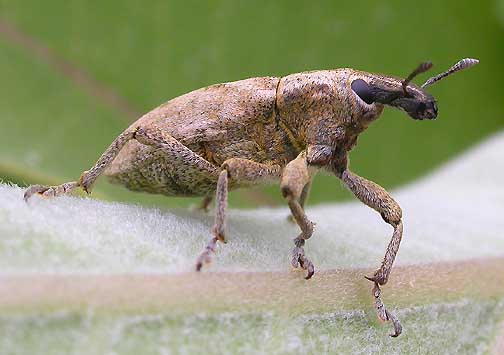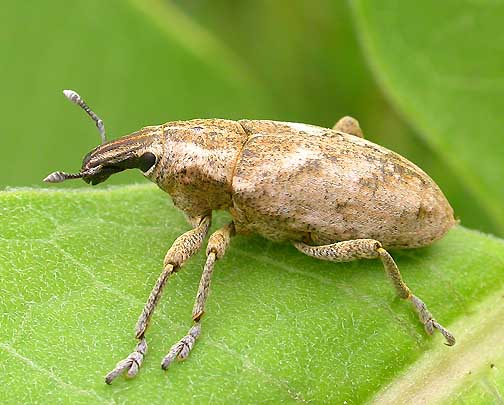June 26th, 2006
a most handsome insect
In this morning’s earlier post about the Black-billed Cuckoo, I mentioned having found two “new” insects during yesterday’s evening walk here at the farm. Before they slip away and become temporarily forgotten in the growing assortment of images that are piling up in my drive, I wanted to post at least one of them. This one seemed to ask to be shared.
The handsome insect in the above and below photos, is a weevil, probably belonging to the subfamily Entiminae (Broad-nosed Weevils) which belong to the Family Curculionidae (Snout and Bark Beetles). Unfortunately, there are so many species in this family, and so few seem to be ID’d in the online collections, that I’m not sure if I’ll ever ID it to species. One of these days, I hope to print off a bunch of photos of all of my “unknowns” and make arrangements to visit one of a couple of the large insect collections in the city to try to do some IDs. However, back to the insect.
This large weevil was seen moving about over a Common Milkweed leaf. Just that fact is probably of some importance, and may provide a clue to its identity. If it’s usually associated with Milkweed, an identity may be easy to establish as insect populations found on Milkweed tend to be well studied. However, leaving issues of ID aside, the real reason that I’m posting this insect is because it seems to have a good deal of aesthetic appeal — at least to me. It has the most wonderful, velvety surface that extends over its entire body (click on the above image to take a look at the larger view and you’ll see what I mean). Also notice how each beautifully sculpted section meets with the next. It’s rather like a highly crafted piece of upholstered furniture! And check out those wonderfully articulated legs, and how neatly each of the jointed sections fits into the next. Gaze at that sleek moose-like face with the stylish smooth, leather-like eyes. Am I alone in thinking this insect is a piece of art?
Seriously, there’s something very sculptural about insects… and for that matter, let’s not stop there. Many other invertebrates share the same quality — snails immediately come to mind, but there are many others. The “engineering” of these creatures is absolutely fantastic. Some of them are so very strong for their size, that you know that they are not only beautiful, but incredibly functional as well. Being able to view these small creatures through the wonder of macro photography is really quite something — and yes, I continue to marvel over this each and every day as I wander about field and forest. I can’t help thinking how lucky we are to have the tools to make it possible to study the world at a level of detail which was virtually impossible even a few years ago.


June 26th, 2006 at 4:07 pm
I can’t believe how closely we can look at creatures on our computers at home. The detail is breathtaking. It makes me fall in love with the smallest of things. Yes, that is truly a handsome weevil. I immediately thought of moose, as well. A real beauty.
June 26th, 2006 at 7:43 pm
Really Cool!
June 26th, 2006 at 9:49 pm
I am in total awe in front of those creatures. They are indeed sculptural. And it’s like some sort of space suit almost. LOL
Thank you so much for the great photography!
June 27th, 2006 at 1:11 am
RA – I often take photos and don’t realize everything that’s going on in the scene until I get home and download the images into my computer. Sometimes I get quite a surprise by the appearance of an insect or spider, or by something it is doing.
–
Jimmy – Yes, it is a cool insect! Some of the weevils are very beautiful.
–
Suzanne – It does look a bit like a space suit. Looks almost hermetically sealed in that velvet suit! Glad you’re enoying the insects photos!
June 27th, 2006 at 10:16 am
OK, three brief comments here: 1. The bug on the milkweed is great. I need to spend some time looking at our milkweeds as we seem to have lots this year.
2. I was very impressed with your cuckoo shot. Cuckoos tend to be hard to see, let alone photograph. We have had both Black-billed and Yellow-billed here on the property this spring and I have yet to even see either one. (I recognize the calls from my youth in Kansas. I rarely saw them there either.)
3. After reading you blog note on Thomas Eisner’s For Love of Insects on Sunday, I ordered it from Amazon.ca. The book was sent out the same day and arrived in the mailbox Monday morning. I could barely drive into town to look for the book that fast. I have never had such fast service from any book seller before. The photos in the book are wonderful and I am enjoying much of the text even though it is, at times, way over my head in chemical vocabulary. I am very glad you wrote about it!
June 27th, 2006 at 10:35 am
That’s a very very fine photo of the weevil, Bev. I’ve also noticed that it’s only when I download the pics and look closely that I see things I hadn’t noticed before. Sometimes it’s rather embarrassing!
To elaborate on OW’s cuckoo comment – I took one look at it and said “yellow-billed cuckoo”, which of course it wasn’t but that’s what we have down here. And yet I very seldom see them – they just blow through, grab up all the caterpillars, and move on. They’re very well-built birds.
I suppose it’s a measure of my “maturity” that I also remark to myself (and to others) how amazing it is how things have changed to allow us to view photographs and information that we’d either have to buy or find in a library, and in the comfort of our own homes! I seldom find book-published photos or identification guides that can match the excellence of those I’ve seen on various blogs and dedicated websites.
I do know people who completely eschew the internet and computer access. They’re not luddites, exactly, and I don’t get the impression that they’re afraid – they have televisions (of course) and they do indulge in all the other usual conveniences. But they either only occasionally use a computer when they absolutely must or they simply refuse to ever use a computer. It’s a bizarre behavior.
I suppose they would counter with statements that I (for example) am “wasting time” or am “addicted”, but we’re talking information and learning here! How can you be “addicted” or “waste time” doing that?
(Then again, I don’t have a cell phone and completely reject that particularly technology, which I suppose is completely bizarre to an obviously huge number of people. But I do it from both practicality (cost and no incentive for being that accessible to demands from others), and an almost invariant observation that cell phones equal inevitable rudeness.)
June 27th, 2006 at 1:55 pm
OW – We have a lot of milkweed this year as well. Further, it seems to be very healthy, with many big leaves – must be related to the wetter weather as it has looked so beaten up the past few summers. Btw, over the past few days, I’ve found several Monarch caterpillars here at the farm and also at a couple of places where I hike. In fact, today’s post was going to be about the caterpillars, but I’ll work on it a bit more before I put it up. Thanks, regarding the Cuckoo shots. They do seem elusive as they go from one bush or tree right into the next. I consider my encounter to be one of those “lucky” ones. (-:
Glad to hear that you’re enjoying the Eisner book. I’m always a little hesitant to recommend books as I hate the thought of someone purchasing a copy of something only to find it isn’t to their liking. I realize that my own taste in books tends to be fairly dry — I don’t read much (or any) fiction these days and am something of a field guide junkie (fancy this coming from someone with an MA in English lit!). I do love detailed accounts of habitat, species, insect or animal behaviour, etc… (both recent and older texts). Eisner’s book seems a good combination of a number of my interests, all told in a very engaging style and with such terrific photos. Hope you enjoy his book.
June 27th, 2006 at 2:16 pm
Wayne – You’re so right about the quality of photos and information that can be found on the net – especially anything related to biology — and especially to insects. In the past, the cost of colour separations made the publishing of colour photographs in biology books quite prohibitive unless the print run was large. Electronic media has changed all of this for the better as far as I’m concerned — especially in the case of insect publications which, let’s face it, aren’t exactly big sellers. If I were relying on all of the books in our library system — and we have quite a good multi-branch system here — I don’t think there were be more than about 20 or 30 decent books, and most of them older and with a very modest number of black and white photos and very few in colour. I’m also in agreement with what you’re written about the net being a good place to come for information. As mentioned to Ontario Wanderer in my previous comment, I’m not much for fiction and definitely not much interested in most television apart from good nature or history documentaries. For me, the internet is a good place to do research, look up IDs for insects, learn more about nature – either from reading research papers that have been published online, or by visiting nature-related or other blogs, the quality of which is often terrific, Niches being one of the best, imo!
(BTW, I seem to be having a mixed up day here — first there were 2 copies of this reply to your comment, then I attempted to remove one and ended up with none — and hopefully this time I got it right – sheesh.. I’m so confused… (-: